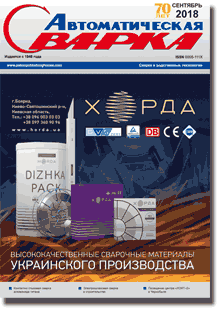| 2018 №09 (06) |
DOI of Article 10.15407/as2018.09.07 |
2018 №09 (08) |

Avtomaticheskaya Svarka (Automatic Welding), #9, 2018, pp. 41-47
Control of the process of base metal penetration at end face electroslag surfacing in current-supplying mould
V.G. Solovyev, Yu.M. Kuskov
E.O. Paton Electric Welding Institute of the NAS of Ukraine. 11 Kazymyr Malevych Str., Kyiv, 03150. E-mail: office@paton.kiev.ua
In the absence of discrete filler of a certain chemical composition, there appears the task of performing end face electroslag surfacing with large-section electrodes. Here, one of the main surfacing quality characteristics is achieving minimum and uniform penetration of the base metal. Main principles of construction of the system of automatic regulation of these parameters at end face electroslag surfacing in a current-supplying mould were developed. Schemes of control of current distribution in the current-supplying mould are proposed, which allow regulation of the process of electrode melting, and, thus, indirect control of the quality of base metal penetration. A particular scheme should be used to produce a sound bimetal joint with provision of regulation of the position of remelted electrode end face in the slag pool relative to the current-conducting section of the mould and maintaining the calculated heat level of the slag pool. 9 Ref., 7 Fig.
Keywords: automation, regulation, penetration, end face electroslag surfacing current-supplying mould, electrode, conductivity
Received: 15.03.2018
Published: 20.09.2018
References 1. Kuskov, Yu.M., Gordan, G.N., Eremeeva, L.T. et al. (2015) Electroslag surfacing using discrete materials of different methods of manufacture. The Paton Welding J., 5-6, 121-123. https://doi.org/10.15407/tpwj2015.06.27
2. Moiseev, V.V., Zakamarkin, M.K., Loiferman, M.A., Chetvertnykh, V.V. (2001) One million of steel ESR was melted using computer. Problemy Spets. Elektrometallurgii, 3, 15-18 [in Russian].
3. Troyansky, A.A., Ryabtsev, A.D., Samborsky, M.V., Mastepan, V.Yu. (2002) Application of information measurement system for study of ESR process. Metall i Lityo Ukrainy, 7-8, 25-26 [in Russian].
4. Vladimirsky, E.I., Ismajlov, B.I. (2011) Synergetic methods of control of chaotic systems. Baku, ELM [in Russian].
5. Dudko, D.A., Rublevsky, I.N. (1962) To problem of nature of barrier effect during electroslag process. Svarka, 4, 40-48 [in Russian].
6. Kuskov, Yu.M., Soloviov, V.G., Zhdanov, V.A. (2017) Electroslag surfacing of end faces with large-section electrode in current-supplying mould. The Paton Welding J., 12, 29-32. https://doi.org/10.15407/tpwj2017.12.05
7. Mironov, Yu.M. (2002) Influence of current nature on processes in electroslag installations. Elektrometallurgiya, 4, 25-32 [in Russian].
8. Soloviov, V.G., Kuskov, Yu.M. (2018) Influence of technological and electrical parameters of ESS in current-supplying mould on electrode melting rate and base metal penetration. The Paton Welding J., 6, 20-27. https://doi.org/10.15407/tpwj2018.06.03
9. Kuskov YuM, Soloviov VG, Osechkov PP, Osin VV (2018) Electroslag surfacing with large-section electrode at direct current in current-supplying mould. The Paton Welding J. 3: 32-35. https://doi.org/10.15407/tpwj2018.03.07
